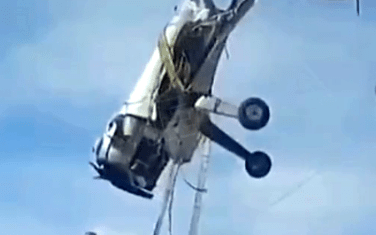A new model of Ukrainian drone hit a Russian military factory more than 1,000 km from the border. The Ukrainian army has reportedly transformed passenger planes into remote-controlled suicide devices to reach such distances.
The Ukrainian army had never struck so deeply. Two Russian industrial sites were hit on April 2, 2024 by a drone attack, in Yelabuga and Nizhnekamsk in the Tatarstan region, more than 1,200 km from the Russian-Ukrainian border. In Yelabuga, the kamikaze device hit a factory, where the famous Shahed drones of Iranian origin are designed. A video was quickly broadcast on social networks showing a passenger plane crashing into the factory.
A source in kyiv told AFP that Ukrainian military intelligence (GUR) was behind the strikes and confirmed that the Shahed factory was indeed the target. The production lines would not have been directly affected, the buildings destroyed in the video would rather be ancillary infrastructure. The model used was not disclosed, but experts quickly looked into these new ULMs remotely controlled from Ukraine.
Russian refineries, new target of the Ukrainian army
The Ukrainian army has already developed several models with a wide wingspan and forward propellers to strike distant targets. However, the shape of the aircraft, the single wing, the tricycle landing gear suggest that it is a tourist plane transformed into a drone and loaded with explosives. As Ukraine produces passenger aircraft, the most likely model would be an A-22 Foxbat.

Military analyst HI Sutton has already noted on his blog that the modified A-22 is a new Ukrainian drone, in his list of weapons used in the war between Russia and Ukraine. The transformation from commercial aircraft to military aircraft is nothing new. The United States and the USSR were already carrying out this process in the 1960s. The technological challenge lies rather in autonomy (battery or tank), long-distance guidance to pilot and the precision of striking the target.
Once the model has been identified, the second question would be: how did a 9-meter-wings plane cross the Russian sky for almost 7 hours? Note that the second strike, on April 2, in Nizhnekamsk, targeted the third Russian oil refinery. The drone used would be different from the modified A-22 and has not yet been identified.


Ukraine has been increasing its deep strikes against energy infrastructure for several months, penetrating Russian anti-aircraft defenses. 12 Russian oil refineries have already been affected, representing 14% of Russian production, estimates Reuters. With Western military aid to Ukraine hampered by political divisions, the military has found a new way to respond to Russia, disrupting its primary source of income. The effect should be felt internationally, since prices have already started to rise.
If you liked this article, you will like the following: don’t miss them by subscribing to Numerama on Google News.
